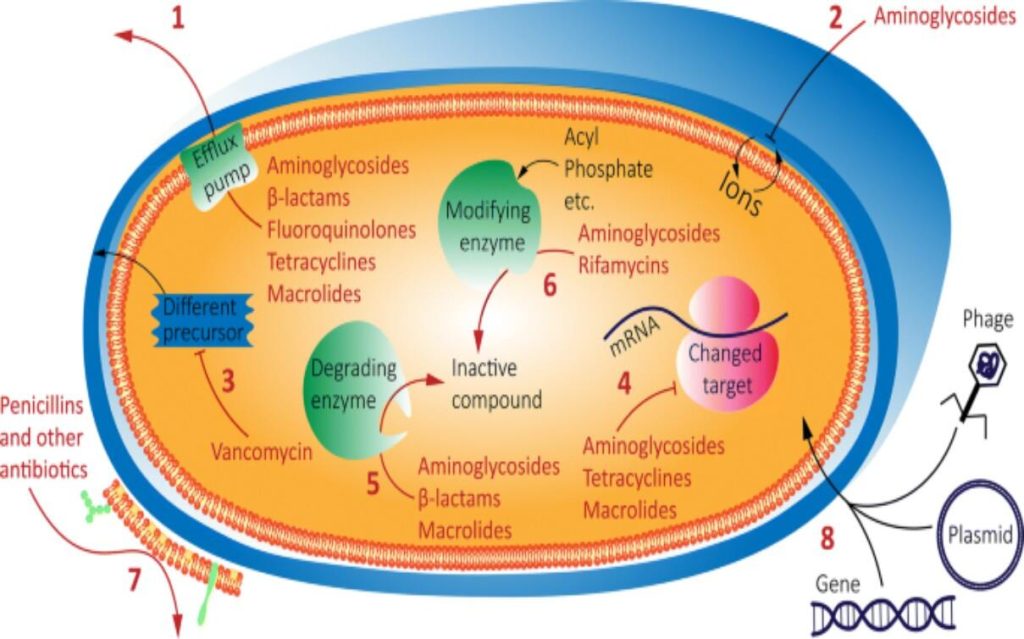In most instances, bacteria are destroyed by the cooperative efforts of phagocytic cells, antibody and complement.
A. Neutrophil (Phagocytic Cell) Engages Bacteria (Microbe): The microbe is coated with specific antibody and complement. The phagocytic cell then begins its attack on the microbe by attaching to the antibody and complement molecules.
B. Phagocytosis of the Microbe: After attaching to the microbe, the phagocytic cell begins to ingest the microbe by extending itself around the microbe and engulfing it.
C. Destruction of the Microbe: Once the microbe is ingested, bags of enzymes or chemicals are discharged into the vacuole where they kill the microbe.
The Immune System and Primary Immunodeficiency Diseases
Immune deficiencies are categorized as primary immune deficiencies or secondary immune deficiencies. Primary immune deficiencies are “primary” because the immune system is the primary cause and most are genetic defects that may be inherited. Secondary immune deficiencies are so called because they have been caused by other conditions.
Secondary immune deficiencies are common and can occur as part of another disease or as a consequence of certain medications. The most common secondary immune deficiencies are caused by aging, malnutrition, certain medications and some infections, such as HIV.
The most common medications associated with secondary immune deficiencies are chemotherapy agents and immune suppressive medications, cancer, transplanted organ rejection or autoimmune diseases. Other secondary immune deficiencies include protein losses in the intestines or the kidneys. When proteins are lost, antibodies are also lost, leading to low immune globulins or low antibody levels. These conditions are important to recognize because, if the underlying cause can be corrected, the function of the immune system can be improved and/or restored.
Regardless of the root cause, recognition of the secondary immune deficiency and provision of immunologic support can be helpful. The types of support offered are comparable to what is used for primary immune deficiencies.
The primary immunodeficiency diseases are a group of disorders caused by basic defects in immune function that are intrinsic to, or inherent in, the cells and proteins of the immune system. There are more than 400 primary immunodeficiencies. Some are relatively common, while others are quite rare. Some affect a single cell or protein of the immune system and others may affect two or more components of the immune system.
Although primary immunodeficiency diseases may differ from one another in many ways, they share one important feature. They all result from a defect in one or more of the elements or functions of the normal immune system such as T-cells, B-cells, NK cells, neutrophils, monocytes, antibodies, cytokines or the complement system. Most of them are inherited diseases and may run in families, such as X-Linked Agammaglobulinemia (XLA) or Severe Combined Immune Deficiency (SCID). Other primary immunodeficiencies, such as Common Variable Immune Deficiency (CVID) and Selective IgA Deficiency are not always inherited in a clear-cut or predictable fashion. In these disorders, the cause is unknown, but it is believed that the interaction of genetic and environmental factors may play a role in their causation.
Because the most important function of the immune system is to protect against infection, people with primary immunodeficiency diseases have an increased susceptibility to infection. This may include too many infections, infections that are difficult to cure, unusually severe infections, or infections with unusual organisms. The infections may be located anywhere in the body. Common sites are the sinuses (sinusitis), the bronchi (bronchitis), the lung (pneumonia) or the intestinal tract (infectious diarrhea).
Another function of the immune system is to discriminate between the healthy tissue (“self”) and foreign material (“non-self”). Examples of foreign material can be microorganisms, pollen or even a transplanted kidney from another individual. In some immunodeficiency diseases, the immune system is unable to discriminate between self and non-self. In these cases, in addition to an increased susceptibility to infection, people with primary immunodeficiencies may also have autoimmune diseases in which the immune system attacks their own cells or tissues as if these cells were foreign, or non-self.
There are also a few types of primary immunodeficiencies in which the ability to respond to an infection is largely intact, but the ability to regulate that response is abnormal. Examples of this are autoimmune lymphoproliferative syndrome (ALPS) and IPEX (an X-linked syndrome of immunodeficiency, polyendocrinopathy and enteropathy).
Primary immunodeficiency diseases can occur in individuals of any age. The original descriptions of these diseases were in children. However, as medical experience has grown, many adolescents and adults have been diagnosed with primary immunodeficiency diseases. This is partly due to the fact that some of the disorders, such as CVID and Selective IgA Deficiency, may have their initial clinical presentation in adult life. Effective therapy exists for several of the primary immunodeficiencies, and many people with these disorders can live relatively normal lives.
Primary immunodeficiency diseases were initially felt to be very rare. However, recent research has indicated that as a group they are more common than originally thought. It is estimated that as many as 1 in every 1,200–2,000 people may have some form of primary immunodeficiency.



